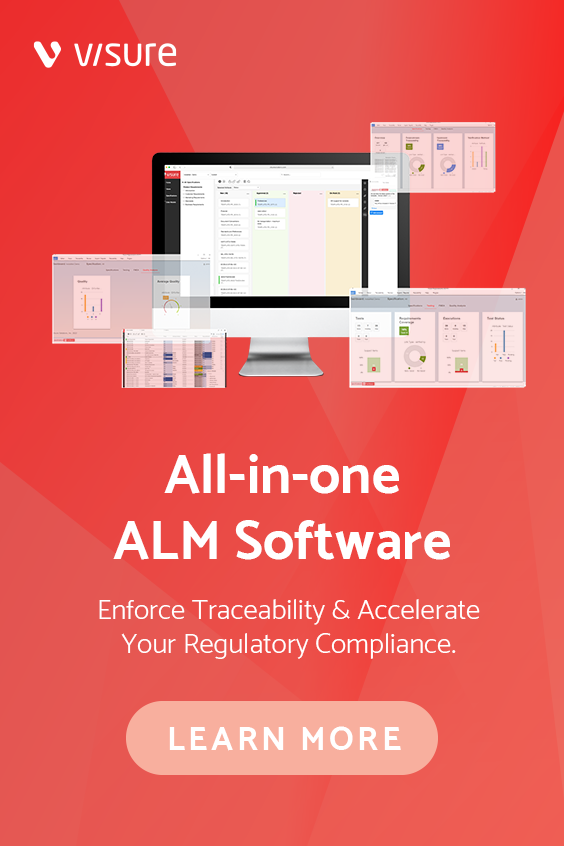In today’s fast-paced development landscape, managing complex requirements, ensuring alignment across teams, and generating thorough test cases have become essential but often time-consuming tasks. Organizations in safety-critical industries, like aerospace, automotive, and healthcare, face increasing pressure to improve efficiency without compromising quality. The good news? Leveraging AI offers a transformative approach to streamline requirements management, enhance accuracy, and accelerate test generation across the lifecycle.
This article explores how an AI-driven approach can help organizations streamline requirements processes, reduce errors, and meet compliance standards with ease.
Revolutionizing Requirements Writing with AI
Effective requirements writing is foundational to any successful project, as unclear or incomplete requirements often lead to delays, rework, and increased costs. Traditional requirements writing can be labor-intensive, involving detailed documentation, stakeholder collaboration, and numerous review cycles. AI-powered tools have begun to change the way requirements are written and managed, addressing common pain points and enhancing productivity.
Key Benefits of AI in Requirements Writing:
- Enhanced Precision and Consistency: AI can analyze existing requirements, spot inconsistencies, and even suggest improvements based on learned patterns.
- Automation of Routine Tasks: Through natural language processing (NLP), AI tools can generate initial drafts or templates, allowing engineers to focus on refining requirements.
- Error Detection and Correction: AI-driven algorithms can detect issues such as ambiguous language or missing components, helping teams catch errors before they progress further in the lifecycle.
By automating the groundwork, AI ensures requirements are not only precise but also easily understandable, enabling teams to create higher-quality specifications with less manual effort.
Streamlining Requirements Management with AI
Once requirements are written, managing them throughout the development lifecycle is crucial. Requirements management often involves version control, traceability, and change management — all of which can be challenging when dealing with large, complex systems. AI brings efficiency and agility to this process by automating tasks that traditionally take a lot of time and resources.
AI-Powered Management Features:
- Automated Traceability: AI can automatically link requirements to design, code, and test cases, maintaining traceability without manual tracking.
- Change Impact Analysis: By analyzing dependencies, AI can predict the impact of any changes made to requirements, reducing potential ripple effects across the project.
- Real-Time Collaboration: AI enables better collaboration by categorizing and structuring requirements data, ensuring stakeholders have access to the latest, most relevant information.
AI-driven requirements management simplifies complex processes and fosters smoother communication across teams, ensuring that everyone stays on the same page and that projects remain aligned with initial objectives.
Generating Tests with AI
Testing is essential for validating that software meets all specified requirements. However, generating comprehensive test cases is traditionally a time-consuming process. AI can be particularly helpful in test generation, producing test cases that cover various conditions, edge cases, and performance scenarios.
How AI Enhances Test Generation:
- Automatic Test Case Creation: Based on requirements data, AI can automatically generate test cases, ensuring thorough coverage and reducing the chance of human oversight.
- Efficient Test Data Management: AI assists in managing and organizing test data to ensure that each test case is properly defined and aligned with corresponding requirements.
- Error Prediction and Defect Analysis: AI tools can identify areas likely to produce errors and automatically prioritize them for testing, increasing testing efficiency and accuracy.
Using AI for test generation accelerates the testing phase and improves the quality of the tests created, ultimately reducing the time and resources needed for validation and verification.
Best Practices for Requirements Management and Traceability
For teams adopting an AI-driven approach, it’s crucial to establish best practices that support traceability and effective requirements management. Proper traceability ensures that each requirement can be tracked from inception to implementation, making it easier to verify compliance and quality.
Key Best Practices:
- Define Clear Traceability Links: AI tools can help automate the process, but teams should also establish clear links between requirements, design, implementation, and testing.
- Use Consistent Requirement Formats: AI thrives on structured data, so it’s beneficial to maintain a consistent format across requirements for maximum accuracy.
- Regularly Update Traceability Matrices: Keep traceability matrices current by leveraging AI-powered updates that reflect any changes in requirements or associated artifacts.
By incorporating these best practices into the AI-driven requirements management approach, teams can maximize their efficiency, maintain high-quality standards, and ensure that each requirement remains traceable across the project lifecycle.
Addressing AI Limitations and Challenges
While AI brings numerous advantages to requirements management, writing, and testing, it’s important to understand its limitations. For instance, AI can struggle with complex or highly nuanced requirements, where human oversight is essential to avoid misinterpretation. Additionally, over-reliance on AI can hinder creativity and human judgment, which are vital for complex projects.
Balancing AI’s Role in Requirements Management:
- Leverage AI for Routine Tasks: AI is best used to automate repetitive and mundane tasks, allowing engineers to focus on strategic and creative aspects.
- Monitor AI-Generated Output: Always review AI-generated requirements, tests, or changes for accuracy to avoid potential pitfalls.
- Incorporate Human Oversight in Critical Stages: In areas where safety or compliance is critical, human review should complement AI analysis to ensure all standards are met.
Finding the balance between AI automation and manual oversight is crucial to fully leveraging AI’s benefits while mitigating its limitations.
Deterministic vs. Statistical Methods in AI-Driven Requirements
AI tools generally employ two types of methods: deterministic and statistical. Deterministic methods follow fixed rules to ensure repeatability and accuracy, which is ideal for traceability and compliance checks. On the other hand, statistical methods rely on probability, making them suitable for error prediction and risk assessment but less so for strict compliance requirements.
Choosing the Right Method:
- Deterministic for Compliance and Traceability: Deterministic methods are ideal for tasks where consistency and reliability are non-negotiable, such as compliance tracking.
- Statistical for Risk Analysis and Prediction: Statistical methods excel in areas like error prediction, where a degree of flexibility and adaptability is beneficial.
By choosing the appropriate AI method for each task, teams can ensure that the AI-driven approach aligns with project needs and maintains the required level of rigor.
“Left-Shifting” AI Automation in the Development Process
“Left-shifting” refers to introducing AI-driven automation early in the development process, such as during the requirements and design phases. This proactive approach improves productivity and quality by identifying potential issues and optimizing processes from the outset.
Benefits of Left-Shifting AI:
- Early Error Detection: By addressing issues early in the lifecycle, AI reduces the risk of errors that could lead to costly rework later on.
- Optimized Development Workflows: AI-driven tools can automate critical tasks from the beginning, streamlining the process and minimizing bottlenecks.
- Risk Reduction: Left-shifting AI reduces risks by implementing safeguards and automated checks early on, enhancing project stability and consistency.
Incorporating AI early in the development process sets the foundation for a streamlined workflow, increasing productivity and minimizing the risks associated with late-stage changes.
Final Thoughts: The Future of AI-Driven Requirements Management
The future of requirements management lies in the balance between human expertise and AI efficiency. As AI technologies continue to evolve, they will unlock new opportunities for increased accuracy, speed, and scalability in requirements management, writing, and testing. However, a thoughtful approach—one that combines AI-driven automation with strategic human oversight—will remain essential to maximizing AI’s potential.
AI-driven requirements management is reshaping the industry, and those who adopt it can expect improved workflows, reduced costs, and a competitive edge. By leveraging AI’s strengths while addressing its limitations, organizations can ensure they are ready to meet the demands of the future.
Check Out The Joint Webinar
Join us for an insightful webinar on “Streamlining Requirements Management, Writing, and Test Generation with an AI-Driven Approach” to discover how cutting-edge AI technologies are revolutionizing the way teams manage requirements, write specifications, and generate test cases.
In this webinar, you will learn:
- The Importance of Requirements Engineering – Highlight the critical role requirements engineering plays in successful project outcomes, ensuring clear, well-defined requirements.
- AI for Requirements Specification – Explore how AI enhances the precision and efficiency of drafting requirements, ensuring alignment with project goals and compliance standards.
- AI-Driven Lifecycle Automation – Discuss how AI can automate the generation of requirements, risks, and tests across the entire development lifecycle, streamlining processes and improving accuracy.
- Best Practices in Requirements Management & Traceability – Review effective practices for managing requirements and ensuring traceability throughout the project, especially in safety-critical systems.
- AI Limitations and Challenges – Examine where AI helps and where it can hinder, finding the balance between AI-driven automation and manual oversight, especially in meeting safety requirements.
- Deterministic vs. Statistical Methods – Compare deterministic and statistical methods at each stage of development, discussing how each approach fits into an AI-driven process.
- Left-Shifting AI Automation – Focus on “left-shifting” AI automation early in the development process to boost productivity, reduce risks, and limit the potential downsides of over-reliance on AI.
- And much more!


